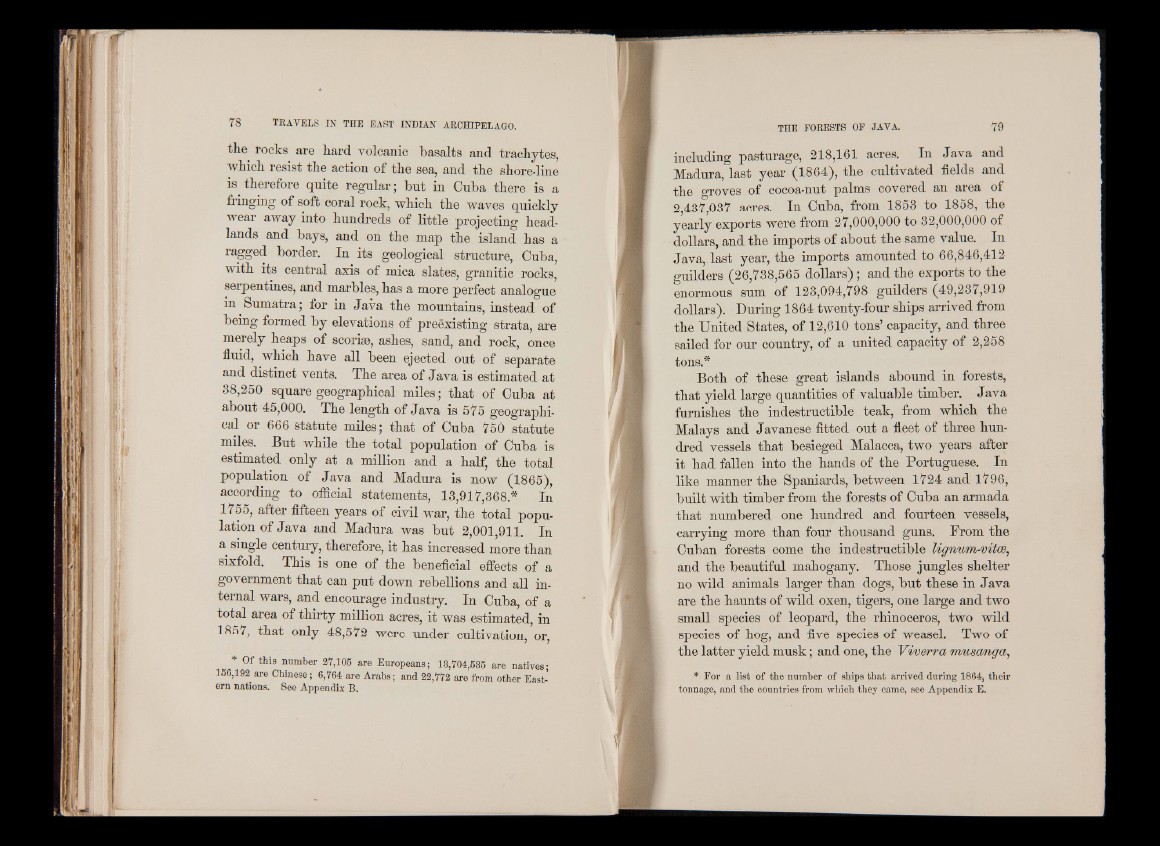
the rocks are hard volcanic basalts and trachytes,
which resist the action of the sea, and the shore-line
is therefore quite regular; but in Cuba there is a
fringing of soft coral rock, which the waves quickly
wear away into hundreds of little projecting headlands
and bays, and on the map the island has a
ragged border. In its geological structure, Cuba,
with its central axis of mica slates, granitic rocks,
serpentines, and marbles, has a more perfect analogue
in Sumatra; for in Java the mountains, instead of
being formed by elevations of preexisting strata, are
merely heaps of scoriae, ashes, sand, and rock, once
fluid, which have all been ejected out of separate
and distinct vents. The area of Java is estimated at
38,250 square geographical miles; that of Cuba at
about 45,000. The length of Java is 575 geographical
or 666 statute miles; that of Cuba 750 statute
miles. But while the total population of Cuba is
estimated only at a million and a half, the total
population of Java and Madura is now (1865),
according to official statements, 13,917,368.* In
1755, after fifteen years of civil war, the total population
of Java and Madura was but 2,001,911. In
a single century, therefore, it has increased more than
sixfold. This is one of the beneficial effects of a
government that can put down rebellions and all internal
wars, and encourage industry. In Cuba, of a
total area of thirty million acres, it was estimated, in
1857, that only 48,572 were under cultivation, or,
* Of this number 27,105 are Europeans; 13,704,535 are natives-
156,192 are Chinese; 6,764 are Arabs; and 22,772 are from other Eastern
nations. See Appendix B.
including pasturage, 218,161 acres. In Java and
Madura, last year (1864), the cultivated fields and
the groves of cocoa-nut palms covered an area of
2,437,037 acres. In Cuba, from 1853 to 1858, the
yearly exports were from 27,000,000 to 32,000,000 of
dollars, and the imports of about the same value. In
Java,, last year, the imports amounted to 66,846,412
guilders (26,738,565 dollars); and the exports to the
enormous sum of 123,094,798 guilders (49,237,919
dollars). During 1864 twenty-four ships arrived from
the United States, of 12,610 tons’ capacity, and three
sailed for our country, of a united capacity of 2,258
tons.*
Both of these great islands abound in forests,
that yield large quantities of valuable timber. Java
furnishes the indestructible teak, from which the
Malays and Javanese fitted out a fleet of three hundred
vessels that besieged Malacca, two years after
it had fallen into the hands of the Portuguese. In
like manner the Spaniards, between 1724 and 1796,
built with timber from the forests of Cuba an armada
that numbered one hundred and fourteen vessels,
carrying more than four thousand guns. From the
Cuban forests come the indestructible Ugnvm-vitCB,
and the beautiful mahogany. Those jungles shelter
no wild animals larger than dogs, but these in Java
are the haunts of wild oxen, tigers, one large and two
small species of leopard, the rhinoceros, two wild
species of hog, and five species of weasel. Two of
the latter yield musk; and one, the Vwerra muscmga,
* Eor a list of the number of ships that arrived during 1864, their
tonnage, and the countries from which they came, see Appendix E.